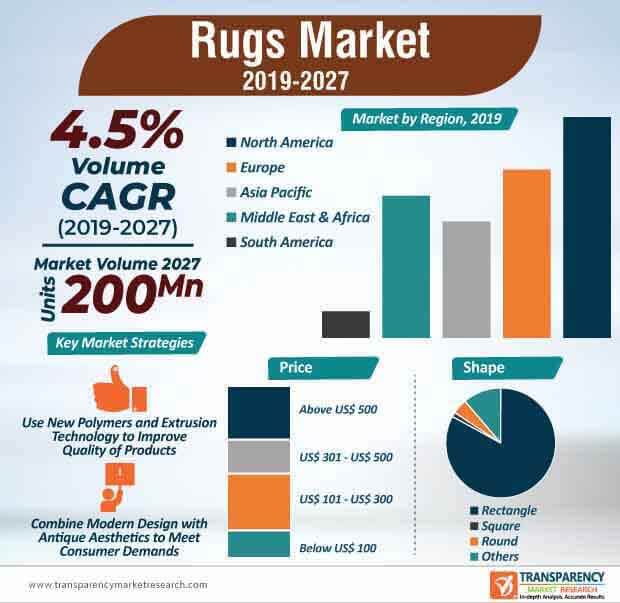
Novel full flooring and accent pieces are setting the design tone for rooms in residential as well as commercial spaces. Hence, manufacturers in the rugs market are increasing their production capabilities to introduce innovative floorcoverings that upend conventional broadlooms. For instance, a French leader in floor and wall coverings has introduced the Tatami System, which is inspired by traditional Japanese Tatami mats that serve as modular floorcoverings to meet the ever-changing needs of users. Such innovations are bolstering the growth of the rugs market, which is estimated to reach an output of ~200 million units by the end of 2027.
Modular rugs are being manufactured to give end users the autonomy to continually adjust spaces as per their taste and requirements. The concept of constantly fluid spaces is being highly publicized in modern workplaces. Innovative rugs are being pervasively used to suit open environments and other collaborative spaces.

Request a sample to get extensive insights into the Rugs Market
Collaborations with Contemporary Artists Offer New Vision in Ancestral Art Showcase
Legacy rug manufacturers are collaborating with ethnically diverse communities to induce traditional art in accent pieces. Manufacturers in the rugs market are leveraging their visibility in the market landscape by participating in design showcases. For instance, Jaipur Rugs— an Indian company that specializes in ancestral craft has collaborated with Italy-based international design studio Matteo Cibic to present their vibrant collection of handcrafted rugs at the Mumbai’s AD Design Show. Thus, strategic collaborations are bolstering revenue in the rugs market, which is anticipated to reach a value of ~US$ 30 Bn by the end of 2027.
To understand how our report can bring difference to your business strategy, Ask for a brochure
Rug Manufacturers in India are taking cues from age-old art form of handmade carpets, thus creating increased work opportunities for rural women artisans. India being one of the leading economies of Asia Pacific is anticipated to boost the revenue of the region to its second-highest position among all regions in the market landscape. Thus, collaborations with the world’s creative talents are providing a new vision to stakeholders in the market landscape.
Man versus Machine: Manufacturers Straddle Traditional Designs with Modern Innovations
The rugs market is anticipated to progress at a modest CAGR of 5.5% during the forecast period. However, scarce availability of handmade antique rugs due to shrinking artisan communities poses as a barrier for market growth. Hence, companies are investing in technologies that manufacture machine-made rugs with antique designs to meet the needs of users. For instance, Safavieh— a high-tech corporation involved with rugs furniture design, has kept innovative designs at the forefront to offer timelessness and character in antique rugs across households in the U.S. This is evident since the rugs market in North America is anticipated to generate the highest revenue by the end of 2027.
Manufacturers are increasing their production capabilities in handmade rugs made from natural fibers to meet ever-evolving needs of users. They are also tapping opportunities in synthetic-fiber machine-made rugs made with family-friendly designs. As such, the revenue of residential applications is predicted to continuously overshadow commercial applications during the forecast period.
Time-honored Techniques Improving Lead Time for Manufacturing Hand-woven Rugs
Manufacturers in the rugs market are generating incremental opportunities by experimenting with different materials such as cashmere, mohair, silk, leather, etc. For instance, SHIIR Rugs— a provider of artisanal rugs designed by leading interior designers, is increasing efforts to travel countries in order to explore ancient-rug making techniques using wool, silk, and leather materials. Manufacturers are collaborating with true cottage industries to ethically and responsibly manufacture rugs with a shared motive for creative exploration. Time-honored techniques are improving the lead time by onboarding laborers from developing economies of Asia Pacific.
Moreover, enhanced durability and clean-ability of rugs are becoming key focus points for manufacturers during their decision-making processes. Hence, manufacturers are extending personalized services in the rugs market to help users with the best material selection according to the foot traffic. On the other hand, customization is playing a pivotal role to meet specific budget parameters of end users.
Read TMR Research Methodology at: https://www.transparencymarketresearch.com/methodology.html
Read Our Latest Press Release:
- https://www.prnewswire.com/news-releases/affordability-and-beneficial-properties-to-serve-as-vital-growth-factors-for-construction-tape-market-during-forecast-period-of-2020-2030-tmr-301221294.html
- https://www.prnewswire.com/news-releases/global-higher-education-solutions-market-to-thrive-on-growing-popularity-of-cloud-computing-and-high-consumption-of-digital-content-tmr-301219732.html





